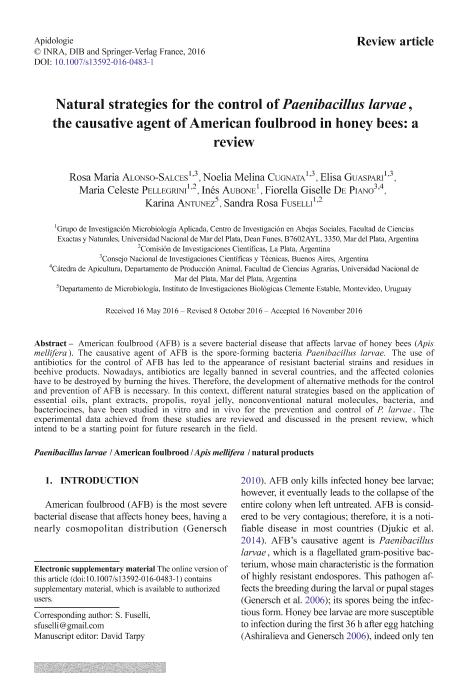Artículo
Natural strategies for the control of Paenibacillus larvae, the causative agent of American foulbrood in honey bees: a review
Alonso Salces, Rosa Maria ; Cugnata, Noelia Melina
; Cugnata, Noelia Melina ; Guaspari, Elisa
; Guaspari, Elisa ; Pellegrini, María Celeste
; Pellegrini, María Celeste ; Aubone, Inés; de Piano, Fiorella Giselle
; Aubone, Inés; de Piano, Fiorella Giselle ; Antunez, Karina; Fuselli, Sandra Rosa
; Antunez, Karina; Fuselli, Sandra Rosa
 ; Cugnata, Noelia Melina
; Cugnata, Noelia Melina ; Guaspari, Elisa
; Guaspari, Elisa ; Pellegrini, María Celeste
; Pellegrini, María Celeste ; Aubone, Inés; de Piano, Fiorella Giselle
; Aubone, Inés; de Piano, Fiorella Giselle ; Antunez, Karina; Fuselli, Sandra Rosa
; Antunez, Karina; Fuselli, Sandra Rosa
Fecha de publicación:
05/2017
Editorial:
Springer
Revista:
Apidologie
ISSN:
0044-8435
Idioma:
Inglés
Tipo de recurso:
Artículo publicado
Clasificación temática:
Resumen
American foulbrood (AFB) is a severe bacterial disease that affects larvae of honey bees (Apis mellifera). The causative agent of AFB is the spore-forming bacteria Paenibacillus larvae. The use of antibiotics for the control of AFB has led to the appearance of resistant bacterial strains and residues in beehive products. Nowadays, antibiotics are legally banned in several countries, and the affected colonies have to be destroyed by burning the hives. Therefore, the development of alternative methods for the control and prevention of AFB is necessary. In this context, different natural strategies based on the application of essential oils, plant extracts, propolis, royal jelly, nonconventional natural molecules, bacteria, and bacteriocines, have been studied in vitro and in vivo for the prevention and control of P. larvae. The experimental data achieved from these studies are reviewed and discussed in the present review, which intend to be a starting point for future research in the field.
Palabras clave:
American Foulbrood
,
Apis Mellifera
,
Natural Products
,
Paenibacillus Larvae
Archivos asociados
Licencia
Identificadores
Colecciones
Articulos(CCT - MAR DEL PLATA)
Articulos de CTRO.CIENTIFICO TECNOL.CONICET - MAR DEL PLATA
Articulos de CTRO.CIENTIFICO TECNOL.CONICET - MAR DEL PLATA
Citación
Alonso Salces, Rosa Maria; Cugnata, Noelia Melina; Guaspari, Elisa; Pellegrini, María Celeste; Aubone, Inés; et al.; Natural strategies for the control of Paenibacillus larvae, the causative agent of American foulbrood in honey bees: a review; Springer; Apidologie; 48; 3; 5-2017; 387-400
Compartir
Altmétricas



